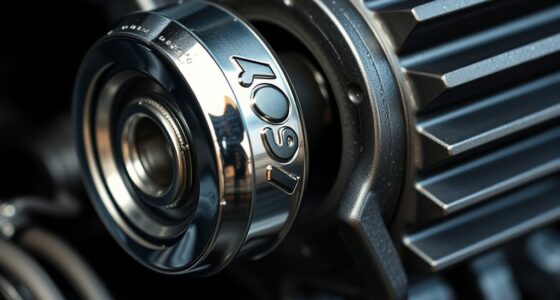If your EGR valve isn’t working properly, you might notice rough idling, hesitation during acceleration, or increased emissions. Common causes include carbon buildup or blockages that prevent the valve from opening or closing correctly. This can lead to engine knocking, higher fuel consumption, and potential failure emissions tests. Regular cleaning and maintenance can keep the EGR system functioning smoothly. Keep going to discover more about diagnosing and fixing these common problems effectively.
Key Takeaways
- EGR problems often stem from carbon buildup, causing blockages that impair exhaust gas recirculation.
- Faulty EGR valves can lead to rough idling, stalling, increased emissions, and poor engine performance.
- Common issues include stuck-open or closed valves, resulting in engine hesitation or failure to pass emissions tests.
- Regular cleaning and maintenance help prevent EGR system failures and ensure compliance with environmental standards.
- Diagnosing EGR problems may involve engine codes, rough running symptoms, or visual inspection of the valve.

Ever wondered why your vehicle might be running rough or producing excess emissions? One common culprit is a faulty Exhaust Gas Recirculation (EGR) system. The EGR valve plays a critical role in reducing nitrogen oxide emissions by recirculating a portion of your engine’s exhaust gases back into the intake manifold. Over time, carbon deposits and dirt can build up on the EGR valve, hindering its ability to open and close properly. This buildup not only affects your engine’s performance but also causes higher emissions. That’s why EGR valve cleaning is often necessary to restore its function. When the EGR valve gets clogged, your engine can experience rough idling, hesitation, or even stalling. Plus, a malfunctioning EGR system can cause your vehicle to fail emissions testing, which is required in many areas to keep your car street-legal. Regular maintenance of your EGR system, including cleaning and inspections, can prevent these issues and prolong your vehicle’s lifespan. Cleaning the EGR valve involves removing it from your vehicle and thoroughly removing carbon deposits and grime. This process can be done at home if you’re comfortable with basic automotive maintenance, or you can have a mechanic handle it for you. Proper maintenance ensures your system functions efficiently, helping your vehicle run smoothly and pass emissions testing without issues. Neglecting this maintenance can lead to increased fuel consumption, engine knocking, and higher pollutant emissions, which are both bad for the environment and your wallet.
In addition to EGR valve cleaning, paying attention to your vehicle’s emissions testing results is essential. When your car fails an emissions test, it often indicates that the EGR system isn’t working properly, allowing excess pollutants to escape. Modern vehicles are equipped with sensors that monitor emissions levels, and if they detect abnormalities caused by a clogged EGR valve, the onboard computer triggers a check engine light. Addressing these issues promptly by cleaning or replacing the EGR valve can help you avoid costly repairs and ensure your vehicle remains compliant with environmental regulations.
Ultimately, understanding the significance of a well-maintained EGR system helps you keep your vehicle running efficiently and cleanly. Regular inspections, timely EGR valve cleaning, and attention to emissions testing results are key steps in preventing more serious problems down the line. If you notice signs like rough idling, increased fuel use, or your check engine light turns on, it’s worth having your EGR system checked out before it leads to more costly repairs or fails an emissions test. Taking care of your EGR system not only benefits your vehicle’s health but also contributes to a cleaner environment.
Frequently Asked Questions
How Can I Prevent EGR Valve Issues From Occurring?
To prevent EGR valve issues, you should perform regular EGR valve maintenance, such as cleaning to remove carbon buildup and inspecting for wear. This keeps the valve functioning properly and helps guarantee emissions regulation compliance. Avoid frequent short trips, which can cause carbon deposits, and use high-quality fuel. Staying on top of maintenance extends the EGR valve’s life, reducing the risk of costly repairs and maintaining your vehicle’s emission standards.
Are EGR Problems More Common in Certain Vehicle Models?
Certain vehicle models, especially those with complex emissions systems, are more prone to EGR problems. You might notice more issues in cars linked to vehicle recalls or needing to meet strict emissions standards. These models often face frequent failures due to design flaws or age. To stay ahead, keep an eye on recalls and guarantee your vehicle’s emissions system remains clean and functioning, avoiding costly repairs down the road.
What Are the Long-Term Effects of Ignoring EGR Problems?
Ignoring EGR problems can seriously harm your vehicle over time. You risk clogging your catalytic converter, which reduces emissions and hampers engine performance. This can lead to decreased fuel efficiency, rough idling, and potential engine damage. The longer you delay fixing it, the more costly repairs become. Address EGR issues promptly to maintain peak engine performance and prevent damage to critical components like the catalytic converter.
Can EGR System Issues Affect Fuel Economy?
Yes, EGR system issues can negatively impact your fuel economy. When the EGR system isn’t maintained properly, it can cause incomplete combustion, leading to increased fuel consumption. Regular EGR maintenance helps guarantee ideal functioning, which improves fuel efficiency. Ignoring these problems may cause your engine to work harder, consuming more fuel over time. So, staying on top of EGR system upkeep is essential for maintaining good fuel economy and engine performance.
How Often Should the EGR System Be Inspected or Cleaned?
Think of your EGR system like a garden that needs regular tending. You should inspect and clean it every 50,000 to 75,000 miles or when you notice issues like rough idling or decreased fuel efficiency. Carbon buildup can clog the system, reducing performance. Sticking to an inspection schedule prevents costly repairs and keeps your engine running smoothly. Regular maintenance ensures your EGR system functions at its best, protecting your vehicle’s health.
Conclusion
Understanding EGR problems is like opening a clogged drain; once you clear the blockage, everything flows smoothly again. By recognizing the signs early and taking action, you prevent engine misfires and costly repairs. Don’t let these issues build up like stubborn grime—address them promptly. With a little effort, you’ll keep your engine breathing easy, running like a well-oiled machine, ready to tackle whatever road lies ahead.









